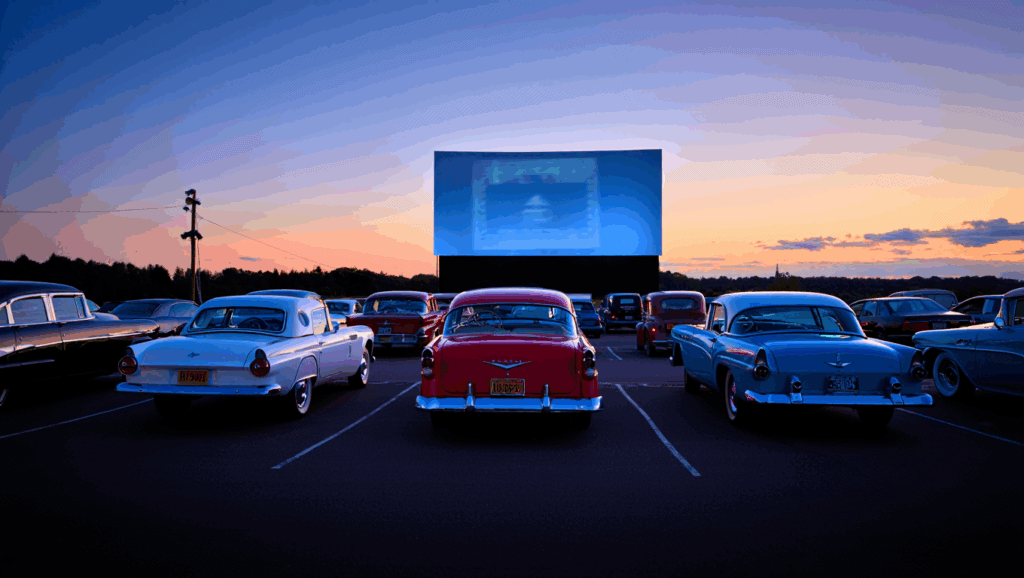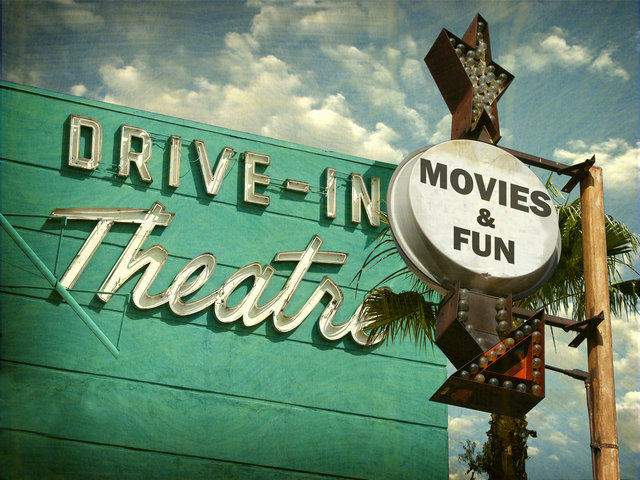Why The Drive In Became A Cultural Stage
The glow of a giant screen, the family sedan eased into a perfect spot, and a speaker clipped to a half-cracked window. That scene defined nights out for millions in the mid-century. 1950s drive in theaters did more than screen movies. They created a place where families, teens, and returning veterans could share an easy ritual that felt both modern and relaxed. The format suited a booming car culture, a baby boom that favored kid-friendly spaces, and towns that were spreading outward along new roads. Cars became living rooms on wheels, and the drive-in became the neighborhood’s open-air den.

A Business Model Built For Suburbs
Suburbs offered cheap land and wide horizons. A single screen could serve hundreds of cars. Concessions brought steady margins on popcorn and sodas. Double features stretched value across a full evening. Parents could keep babies asleep in the back seat while older kids watched heroes on the screen. The experience solved many problems of the time, which is why fields filled quickly whenever the gates opened.
For a gentle primer on how the format grew, you can skim historical overviews at the Smithsonian Magazine and regional histories collected by American Heritage. These reads offer context that pairs well with personal memories from families who still visit surviving screens each summer.
Cars As The Co-Stars
Design That Served The Screen
Cars of the era were not only a means of transport. They were furniture and fashion. Wide bench seats allowed couples to sit close and parents to settle children with blankets and a shared thermos of cocoa. Tail fins and chrome were not just a style. They caught the last light in the lot and made every arrival feel like a tiny parade. Classic cars helped create the silhouette of the drive-in night. A field of Bel Airs and Fairlanes turned a parking lot into a stage set.
Sound That Moved To The Dashboard
Early speakers hung on posts and clipped to windows. Sound drifted to the couple in front and to the family in back. As technology improved, some lots offered low-power radio signals so the film played through each car’s system. The change made cabins feel like private theaters and set the tone for later in-car media. The drive-in taught manufacturers that people wanted their dashboards to serve music, maps, and news with comfort.
Teens, Freedom, And Sock Hop Energy
The Lot As A Social Map
Teens found a safe place to gather that felt separate from home while still close enough for an adult eye. Friends cruised for a spot near a group they knew. Horn taps and waving headlights became a small language. The lot mapped social life as clearly as any dance floor. Sock hop culture moved from gym floors to gravel lanes and car hoods, where shakes from the snack bar replaced punch bowls and headlights outlined impromptu photo ops.
Fashion And Ritual
Letterman sweaters, circle skirts, rolled jeans, and saddle shoes turned the lot into a fashion show. Jackets came off and blankets came out when the second feature started. Sharing a lap blanket became a rite of passage for couples. The ritual felt playful and public without being noisy. Theater owners reinforced that mood with intermission reels that invited folks to the snack bar with cartoon hot dogs and tap dancing soda cups. For a visual taste of those reels, the curated clips on the Internet Archive are a delight.

Family Nights And Community Life
Kids In Pajamas
Parents loved the low-stress plan. Children climbed into pajamas before the family left the driveway. No ushers shushed them. No long aisles required, balancing a toddler and a tray. If a baby cried, the windows were closed and the sound stayed inside the car. The drive in fit a world that was welcoming new babies at a historic pace. A single night could serve three generations in one row.
Fundraisers And Local Pride
High school bands, scout troops, and civic clubs partnered with owners for benefit nights. The screen doubled as a community bulletin board. Local cartoons or slides thanked sponsors between features. That local pattern still survives at many independent lots that host car shows and holiday events. For listings and preservation stories, Historic Route 66 through the National Park Service is a helpful jumping-off point when you plan a nostalgia road trip.
The Films That Played Best
Double Features And Genre Mixes
Western followed by romance. Monster movie followed by teen comedy. The program flowed like a playlist that aimed to please an entire car. The first film pleased families. The second learner was older and started late. Studios learned to cut trailers that read well on giant outdoor screens. Large faces, bold titles, and high contrast made sense when viewers watched from a hundred feet away.
Cult Favorites And Local Sensation
Regional horror and beach party flicks gained followings because drive-in screens welcomed low-budget spectacle. A clever poster and a good title could fill a field for a weekend. That pattern foreshadowed later cult circuits at midnight screenings in indoor theaters. The drive-in taught promoters how to sell vibe as much as plot.
Route 66 And The Open Road
The Highway That Carried The Culture
Route 66 carried families west and stitched small towns into a shared story. Neon signs promised barbecue, clean cabins, and air-conditioned theaters. Drive-ins near the highway became evening anchors on long trips. A car might collect a map stamp at a gas station in the afternoon and a popcorn box at the local screen after dark. The road culture fed the theater culture and vice versa.
Architecture And Icons
Screens rose like billboards against the sky. Projection booths doubled as snack bars to save staff. Entrance arches welcomed cars with smiling mascots. Many lots added miniature playgrounds near the screen so kids could run before the first reel. The design language mixed roadside charm with pragmatic needs. It remains one of the most recognizable visual sets in American life.
What Changed And What Survived
Television Arrived At Home
Television brought films and shows into living rooms. Air conditioning made indoor theaters more pleasant in hot months. Land values rose as suburbs matured. Many drive-ins sold ground to grocery chains and developers. Yet a surprising number survived by adapting. Some added weekend flea markets by day and movies by night. Some paired screens with diner-style kitchens and craft popcorn bars that made the concession stand a reason to visit on its own.
New Waves Of Nostalgia
Cultural interest comes in cycles. Families rediscovered the format during moments when distance felt thoughtful, and communities rallied to keep local screens lit. Restaurateurs opened car hop service beside the lots and invited owners of classic cars to stage show and shine nights. Vinyl records, milkshakes, neon signs, and chrome-edged stools returned to the scene as friendly symbols of American nostalgia.
For current programming and preservation updates, independent theater associations and local historical societies post schedules and restoration notes. Regional newspapers also run summer guides to outdoor movies that make planning easy.
How The Legacy Lives In Today’s Media Habits
The Car As Entertainment Space
Touchscreens and streaming inside vehicles did not appear by accident. Designers study how families spend time in cars. The drive-in era proved that people liked to share stories on wheels. That insight echoes in rear seat screens, better cabin acoustics, and park in events where live concerts transmit sound through FM signals.
Pop Up Culture And Food Trucks
Outdoor screens now appear in parking lots and on rooftops with food trucks parked nearby. The format feels familiar because the mid-century laid the groundwork. People still enjoy a sky above, a casual seat, and a bite that tastes best under string lights.
Planning Your Own ’50s-Inspired Night
Find A Surviving Screen
Check state listings and community pages to find a nearby theater that still lights a field at dusk. Many venues keep active Facebook or Instagram pages with weather calls and movie lineups. Some sell tickets online so queues move smoothly at the gate.
Dress The Part Lightly
You do not need a full costume to feel the era. A cardigan over a simple dress, rolled denim, a bandanna, or a pair of saddle-style sneakers nods to the time without fuss. Pack a blanket, a small speaker if the theater allows cabin audio through radio, and a trash bag so your spot stays tidy.
Order Like A Regular
Corn dogs, burgers, shakes, and popcorn define the menu. Many concession stands now add veggie options and craft sodas. Buying snacks inside supports the screen. It also completes the sensory memory that makes these nights feel special.
For road trip ideas that pair screens with diners and neon motels, browse the travel features and small town guides at Roadtrippers and preservation stories in Atlas Obscura.
Picture Ideas And Alt Text Notes
Lot And Screen
Wide frame of cars facing the screen at twilight. Alt text. Classic sedans line up as the sky turns blue and the first title card appears.
Concession And Ritual
Counter view with popcorn and neon menus. Alt text. Hands pass a striped tub of popcorn at a stainless steel counter.
Fashion And Friends
Group shot on a car hood before showtime. Alt text. Friends in retro-inspired outfits smile as the screen warms up.
Route And Memory
Roadside sign near the entry. Alt text. Vintage marquee points toward the drive-in with arrows lit in small bulbs.
Final Thoughts
1950s drive-in theaters shaped how America watched films, dated, raised kids, and designed cars. They blended private comfort with public fun in a way that still feels wise. The format invited people to slow down under a wide sky and share a story together. Visit a surviving screen if you can. Roll down the windows and let the projector hum become part of your evening. In that soft light, the past and present sit side by side, and the big screen belongs to everyone in the lot.
